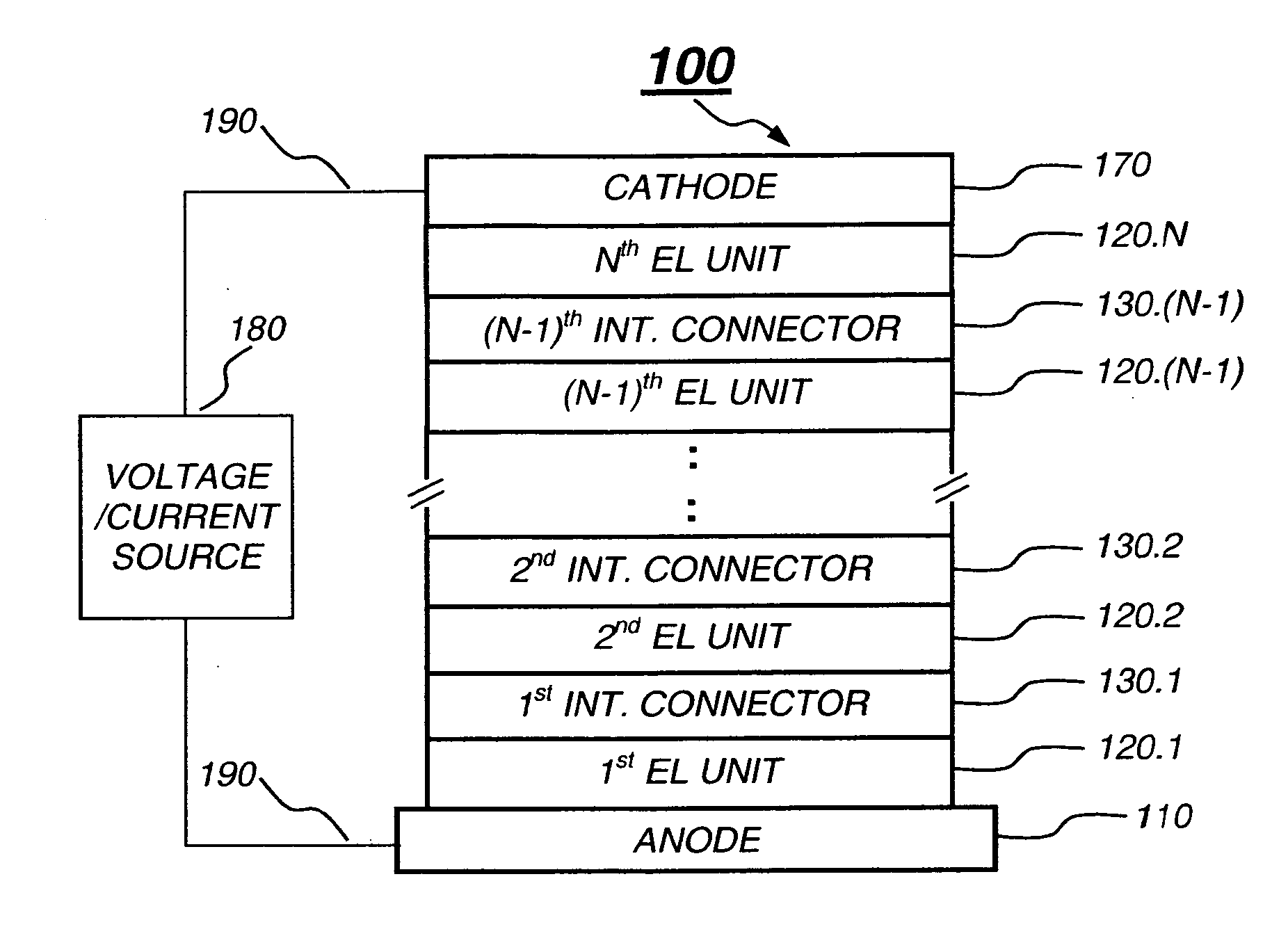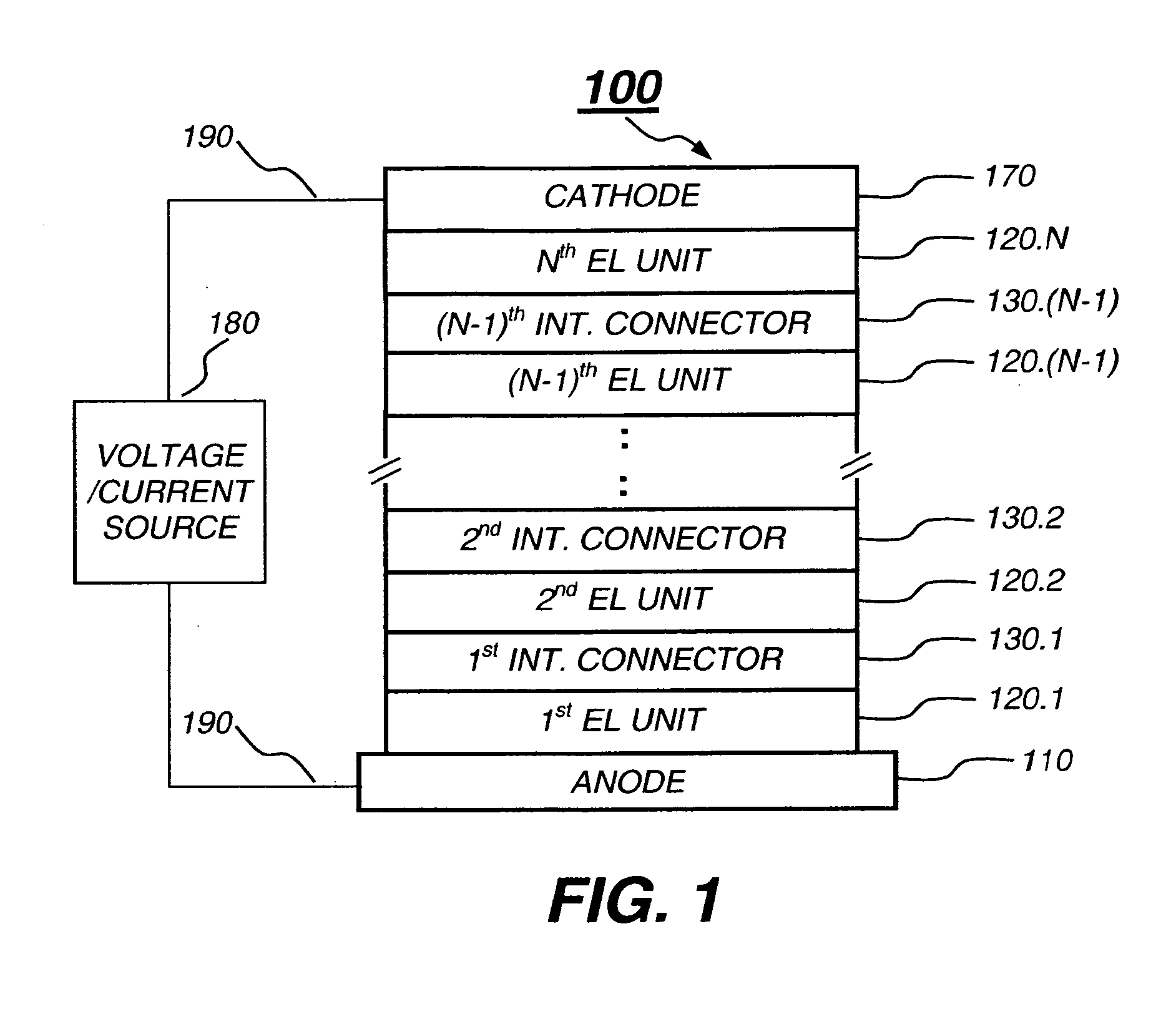Tandem OLED device
a technology of oled device and oled ring, which is applied in the direction of organic semiconductor device, discharge tube luminescnet screen, natural mineral layered product, etc., can solve the problems of increased drive voltage, limited voltage available, short lifetime, etc., and achieves low drive voltage, high efficiency, and long lifetime
- Summary
- Abstract
- Description
- Claims
- Application Information
AI Technical Summary
Benefits of technology
Problems solved by technology
Method used
Image
Examples
example 1
Comparative
[0125] The preparation of an OLED having a single white light-emitting organic EL unit was performed as follows.
[0126] A ˜1.1 mm thick glass substrate coated with a transparent indium-tin-oxide (ITO) conductive layer was cleaned and dried using a commercial glass scrubber tool. The thickness of ITO was about 42 nm and the sheet resistance of the ITO was about 68 Ω / square. The ITO surface was subsequently treated with oxidative plasma to condition the surface as an anode. A layer of CFx, 1 nm thick, was deposited on the clean ITO surface as the hole-injecting layer by decomposing CHF3 gas in an RF plasma treatment chamber. The substrate was then transferred into a vacuum deposition chamber for deposition of all other layers. The following layers were deposited over the CFx layer in the following sequence by evaporation from heated boats under a vacuum of approximately 10−6 Torr:
[0127] a) an HTL, 60 nm thick, including 4,4′-Bis[N-(1-naphthyl)-N-phenylamino]biphenyl (NPB)...
example 2
Inventive
[0135] A tandem OLED of device having two white light-emitting organic EL units was prepared by depositing a first EL unit, a connector, and then a second EL unit over the CFx layer, as described below.
First EL Unit
[0136] a) an HTL, 60 nm thick, including NPB;
[0137] b) a yellow light-emitting layer including 20 nm of NPB doped with 3% Compound 1 (yellow light-emitting dopant) and 20% by volume Compound 2 as stabilizer;
[0138] c) a blue light-emitting layer including 20 nm of Compound 2 with 1% by volume Compound 3 (blue light-emitting dopant) and 6% by volume NPB co-dopant forms a blue emitting layer; and
[0139] d) 5 nm ETL including Alq as the electron-transporting material.
First Connector
[0140] a) 20 nm thick n-type doped organic layer, including 20 nm Bphen as the electron-transporting material doped and doped with 2% by volume Li metal; and
[0141] b) 2 nm tungsten oxide (WOx).
Second EL Unit
[0142] a) an HTL, 60 nm thick, including NPB;
[0143] b) a yellow light...
PUM
| Property | Measurement | Unit |
|---|---|---|
| reduction potential | aaaaa | aaaaa |
| work function | aaaaa | aaaaa |
| thickness | aaaaa | aaaaa |
Abstract
Description
Claims
Application Information
 Login to View More
Login to View More - R&D
- Intellectual Property
- Life Sciences
- Materials
- Tech Scout
- Unparalleled Data Quality
- Higher Quality Content
- 60% Fewer Hallucinations
Browse by: Latest US Patents, China's latest patents, Technical Efficacy Thesaurus, Application Domain, Technology Topic, Popular Technical Reports.
© 2025 PatSnap. All rights reserved.Legal|Privacy policy|Modern Slavery Act Transparency Statement|Sitemap|About US| Contact US: help@patsnap.com



